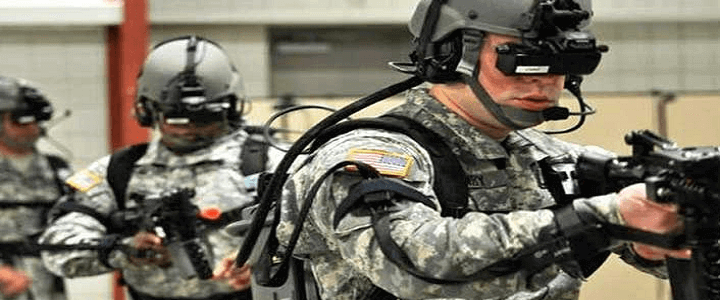According to a research from Market Study Report, LLC, the 2018 global Military Virtual Training market will reach $9.93 billion, and is expected to grow to $10.8 billion by the end of 2025. While it may seem like an emerging and fast-growing market, simulated training isn’t exactly new – even if the way it is being employed has evolved over the past 90 years.
The original Link Trainer, the first flight simulator that was used to teach pilots how to fly by instruments was developed in 1929 by Edwin Albert Link of Binghamton, NY. Link used his knowledge of pumps, valves and bellows to create a flight simulator that could mimic and respond to the pilot’s controls, and provided an accurate reading on the included instruments.The Link Trainers became crucial for training American pilots during World War II, but were also employed by many other combatant nations.
Today the technology used for this sort of training is actually similar to that of a video game, and this has increased the realism while bringing costs down. This is where virtual reality (VR) and augmented reality (AR) come into play. In fact, the U.S. military has been utilizing VR since 2012, but increasingly with proprietary hardware and software.
VR/AR Soars With the USAF
VR’s use by United States Air Force goes beyond traditional flight simulators, and isn’t just being used by pilots, either.
In January the USAF offered a demonstration of how VR along with AR – virtual overlapped with the physical world – could benefit training. The demonstration was geared towards airmen within the aircraft armament systems and munitions systems, and provided a glimpse of how VR/AR applications could aid in providing an enhanced experience to Airmen preparing aircraft for combat missions.
The VR/AR training, held at Joint Base Langley-Eustis, allowed users to feel like they were walking inside a hanger with a piece of munitions positioned for maintenance. While donning the VR headset, the user could look around the hanger and interact with the real munitions.
U.S. Military Hits Up Start-Up VR
In April, HTX Labs, LCC, the creator of enterprise immersive training and simulation programs for global business entities and government organizations, announced that it was the recipient of a U.S. Air Force Small Business Innovation Research (SBIR) Phase I award.
That award provided funding for the continued development of training simulations built on HTX Labs’ EMPACT VR platform that was designed to enhance student understanding, retention and mastery of military procedures and protocols.
“We are honored to be an SBIR Phase I Select company, and are excited to help the Air Force train the aviator of the future,” said Scott Schneider, co-founder and CEO of HTX Labs, via a statement. “The ability for a startup to work with any branch of the military based on the SBIR process is a tremendous opportunity, and we’re looking forward to developing simulations that improve student responsiveness and accuracy to situations that are inherently dangerous. We want to keep our military personnel safe, and immersive training plays a big role in meeting that objective.”
The SBIR Phase I award follows successful deployments of VR-based programs by HTX previously initiated for the Air Force’s Pilot Training Next (PTN) program, and provides a fast-track mechanism for any branch of the military to work directly with the firm on training simulations.
The Houston-based commercial software company will provide the USAF with this technology to provide training that allows students to perform their job in a completely safe and controlled environment – and experience a life-like situation that might not otherwise be possible.
“HTX has provided us an immersive emergency procedure trainer that filled an essential gap in our pilot training program,” said Paul ‘Slew’ Vicars, lead for the PTN program, via a statement. “They are a responsive and attentive company that has been great to work with!”
VR and the Army
The U.S. Army has been also been adopting VR for battlefield simulations and medic training. These simulations can help soldiers train for dangerous settings in a more cost effective manner than traditional approaches.
Last fall it was announced that the U.S. Army had awarded Bohemia Interactive Simulations (BISim) a major extension to demonstrate technologies that include a cloud-enabled, VR world. The contract award also met the requirements of the Army’s Synthetic Training Environment (STE) initiative, which aims to see the convergence of virtual, constructive and gaming training environments into a single cohesive system.
VR is the new reality for military training.
“VR can be used for many functions in the military, from training fighter pilots, mechanics, and ground troops to supporting real-time mission with robotics and unmanned vehicles like UAVs,” said Jim McGregor, principal analyst at TIRIAS Research.
“By providing an immersive experience, you can train to do just about anything, even rehabilitation for injuries,” McGregor told ClearanceJobs. “When combined with robotics, VR can allow personnel to venture into dangerous situations but see everything they would see if they were present. The same is true with UAVs. So, VR can support training, as well as real-time missions.”



